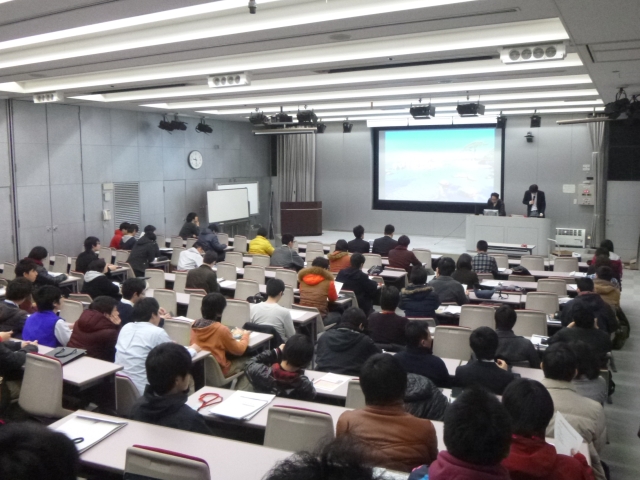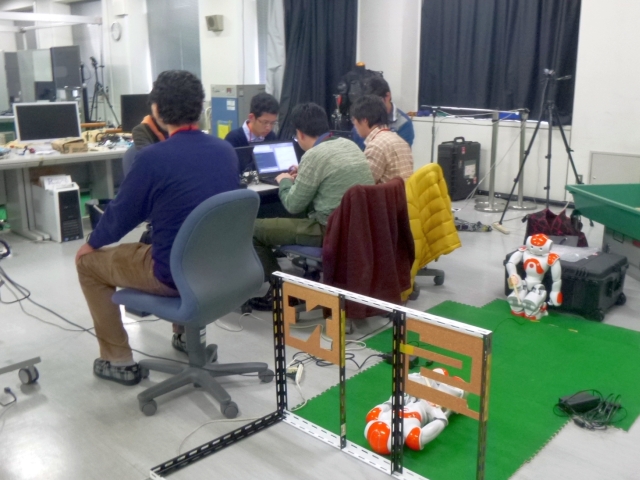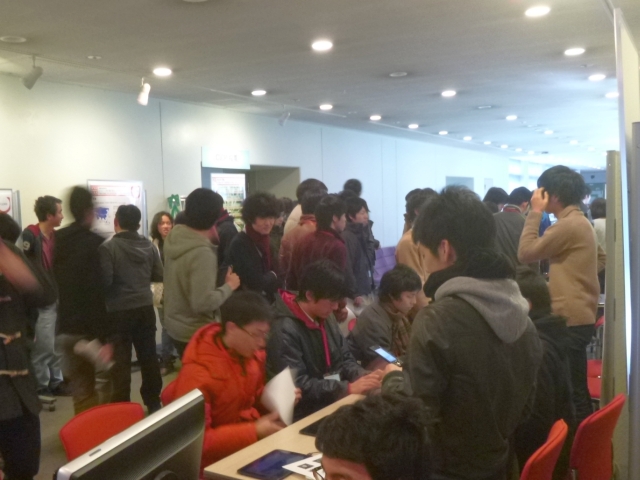Graduate School of Information Science, NAIST
Spring Seminar
March 5-6, 2015
Summer seminar 2014 will be held in Graduate School of Information Science, NAIST March 5 - 6. You can experience the cutting edge of the information science research during this summer seminar.
We look forward to your apply!



| Date | March 5 - 6, 2015 | Venue | Graduate School of Information Science, NAIST (Takayama 8916-5, Ikoma, Nara 630-0192, Japan), or Online |
|---|---|
| Admission policy | Education higher than undergraduate including non-academic applicants who are planning to become IS students. If you are not a candidate, please apply the Lab tour |
| Capacity | Depends on each theme (please check the table below). If the number of applicants exceeds the capacity, a selection process will be done by the corresponding laboratory. |
| Admission fee | FREE! However, we don't cover any travel or accommodation costs. |
| Application form | Done|
| Contact us | Summer Seminar Committee ss1503/at/is.naist.jp (change /at/ to @) |
What's new
- 2015.2.13 Results are here(Assignment list)
- 2015.1.30 Information about submission DL and results notification are updated
- 2014.12.22 Open the website and the themes were listed
Schedule
- March 5th
09:20 Registration (IS L1 lecture room)
09:30 - 10:40 Introduction (IS L1 lecture room)
10:40 - 17:00 Seminar (Lab.)
- March 6th
09:20 - 12:00 Seminar (Lab.)
12:00 - 13:30 Social lunch (IS L1 lecture room)
13:30 - 16:40 Seminar (Lab.)
16:50 - 17:20 Celemony (IS L1 lecture room)
Themes
Some courses will be carried out only in Japanese. See these details in the Japanese page.
| No. | Theme | Summary | Lab. | Qualification | Capacity |
| 1 | Design and implementation of mobile ad-hoc network protocol using XBee | The participants will design and develop a mobile ad-hoc network protocols that works on real XBee devices. XBee devices can be easily programmed with Java programming language. | Foundations of Software Lab | Experience in Java programming is preferred | 3 |
| 2 | Implementation of Basic Image Inpainting Algorithm | Image inpainting is a technique to remove undesired objects in an image. You learn image inpainting algorithms and implement one of the algorithms. | Vision and Media Computing Lab | Programming experience in C | 3 |
| 3 | Simulator Developing for Mobile Ad Hoc Networks | The goal of this project is to learn simulation methods for mobile ad hoc networks. Specifically, the participants will develop a simulator for mobile ad hoc networks to simulate network behaviors, such as node mobility, packet generating, distributing and delivering processes. | Foundations of Software Lab | Experience in C,C++ or Java programming | 4 |
| 4 | The Search for OSS Experts - Study of Big Data Mining through One Million Developers in OSS World - | Who develop open source software? Why many companies use open source software? You study the reason for the success with a real data set of open source software projects. In this theme, you will be able to study bigdata-mining techniques (e.g., source code statical analysis, repository mining, social network analysis). | Software Engineering Lab | Programming Experience | 5 |
| 5 | Image processing for augmented reality | In this theme, you will work on augmented reality technology, which superimposes CG objects in a real-time stream from a USB camera capturing the real environment. Specifically, you will aim at realizing a system that shows CG objects and your hands with correctly reproducing their occlusion relationship by detecting skin-colored regions in the real-time stream. For more detail, please visit our webpage at: http://yokoya.naist.jp/ | Vision and Media Computing Lab | Experience in C/C++ programming desirable | 3 |
| 6 | Computer control for mechatronics system: from theory to application | "We study the theory and mechanism of computer control used for various systems such as robots and vehicles. Furthermore, we apply it to control an electric motor using a well-known design tool MATLAB. Keywords: control engineering, PID control, modeling, optimal control" | Intelligent System Control Lab | none | 4 |
| 7 | Visualization and Exploration of 3D Source Code Cities | Understanding entire source code in large software projects is a difficult problem. In this course, we will address this problem by visualizing source code as 3D cities. The participants will (i) collect metrics of all source code files, (ii) build 3D city visualization using the metrics, and (iii) explore their own cities in two days. | Software Engineering Lab | Programming Experience | 5 |
| 8 | Interactive Projection Mapping | We will develop a projection mapping system which consists of a projector and a camera, based on Augmented Reality technology. Using this system, you can draw virtual lines on a physical object in the real space. Specifically, you can learn about how to estimate the coordinate of drawing pen tip and how to calibrate a relationship between a projector and a camera. | Interactive Media Design Lab | Programming Experience (C/C++) | 4 |
| 9 | Development of Augmented Reality Interface on Mobile Devices | Augmented Reality is a technology that can display various information intuitively by merging between a real environment and a virtual environment. We will develop a user interface for an augmented reality system, which enables user to locate computer-generated objects in the merged environment. In this practice, using mobile devices (iOS/Android devices) or wearable devices (Google Glass), you can learn about matrix transformations that is needed to realize augmented reality. | Interactive Media Design Lab | Programming Experience (C/C++/C#) | 3 |
| 10 | - | - | - | - | - |
| 11 | - | - | - | - | - |
| 12 | - | - | - | - | - |
| 13 | Acceleration and Evaluation Techniques of Graph Analysis on Variety of Hardwares | "The target graph applications are triangle-counting and dijkstra. You can challenge the implementation, parallelization, and evaluation of these applications on muticore system, GPU, XEON/Phi and special purpose hardware (EMAX)." | Computing Architecture Lab | Programming Experience in C | 4 |
| 14 | Introduction to eye tracking and its applications | "Eye tracking is used in various fields including psychology, neuroscience, marketing research, and user interface. In this seminar, participants will learn basic principles, measurement procedure, and its applications." | Mathematical Informatics Lab | none | 2 |
| 15 | Analyze Variation of Human Body using Medical Imaging – Basics of Computational Anatomy | Medical imaging such as CT or MRI is ubiquitous in hospitals and is an essential tool for diagnosis and treatment planning. Currently, medical imaging is used for checking an individual patient. An emerging research field called ‘Computational Anatomy’ digs into information buried in medical images of a large cohort to reveal essential questions in population study, e.g., what is the variation of organ shapes in human beings?, what is the characteristic organ shape specific for a certain disease? In this summer camp, the participants will learn basics of computational anatomy and implement simple software by themselves. | Imaging-based Computational Biomedicine Lab | Programming experience is a plus | 3 |
| 16 | Surgical Assistance using GPS – Basics of Surgical Navigation System | The car navigation system tells you where you are with the assistance of the Global Positioning System (GPS) and is becoming an essential tool for drivers. The same technology is becoming popular in surgery. The surgical navigation system localizes the patient and surgical tools using a 3D tracking sensor, which helps surgeons to identify the position and orientation of the tool with respect to the patient. It improves safety in an accuracy-critical surgery such as needle insertion into a deep target or implantation of an artificial object into the patient’s body. In this summer camp, the participants will learn basics of the surgical navigation system using an actual tracking sensor and a human body phantom, as well as discuss about its advantages and disadvantages from the surgeon’s perspective. | Imaging-based Computational Biomedicine Lab | Programming experience is a plus | 3 |
| 17 | Principle of Wireless Power Transfer | There is a growing demand for wireless power transfer and its applications such as battery charging systems for mobile devices and power supply for electric automobiles. The objective of this two-day learning course is to understand the principle of the wireless power transfer techniques. In this course, we first measure the power transmission efficiency using our RF vector network analyzer. Then we measure the transfer characteristics using our wireless power transfer testbed. Through these experiments and theoretical analysis, we can get the principle of the wireless power transfer techniques. | Network Systems Lab | There is no mandatory requirement. However, the knowledge on the high school physics level basic electrical circuit theory is helpful for understanding the contents of this seminar. | 3 |
| 18 | Knowledge Discovery from Big Data | We analyze the big data with large scale computers and discover the useful knowledge. From the big data, the participants will build a hypothesis and analyze whether the hypothesis would be right. | Augmented Human Communication Lab | none | 3 |
| 19 | Virtual network programing for Cloud computing | "In this seminar, we will learn about virtual network programing, which is an emerging technology for Cloud infrastructures. Cloud computing has been actually brought on by server virtualization, but for the next step, network virtualization has been also focused on. SDN (Software Defined Network) technology, introducing programmability into network infrastructures, has therefore gathered a lot of attention. We will learn how to program virtual networks using OpenFlow, a typical implementation of SDN." | Software Design and Analysis Lab | Basic programming skills. Experience in Ruby is preferred. | 3 |
| 20 | Let's describe safety and security of software systems | "Recently, many consumer systems like automobiles and houses are connected to networks so that we can enjoy new kinds of benefits. On the other hand, many people have some anxiety about the risks caused by those system. In this exercise, students will analyze the risks on the target consumer system and describe the result in a way that users can be convinced and assured." | Software Design and Analysis Lab | none | 3 |
| 21 | - | - | - | - | - |
| 22 | - | - | - | - | - |
| 23 | Object recognition and manipulation | We employ the robot which has a manipulator to learn how to recognize the object from a camera image and to manipulate it based on the recognition. We implement the algorithm by using a robot middleware on the robot. | Robotics Lab | Programming experience in some programming language | 3 |
| 24 | Automatic error correction of English learners' writings | Learners of English as a foreign language make a number of grammatical errors in their writings. In this task, you will learn how the current natural language techniques are used for detecting and correcting typical grammar errors such as incorrect usage of English prepositions. | Computational Linguistic Lab | Experience of using a programming language for handling text data is requested. | 4 |
| 25 | - | - | - | - | - |
| 26 | - | - | - | - | - |
| 27 | - | - | - | - | - |
| 28 | - | - | - | - | - |
Lab tour
Please visit Lab Tour.
Access
Please visit Access Map.
Accommodation
Please visit FAQ (in Japanese).
